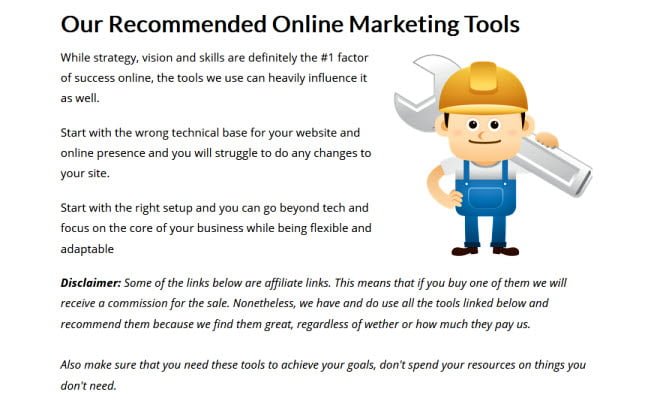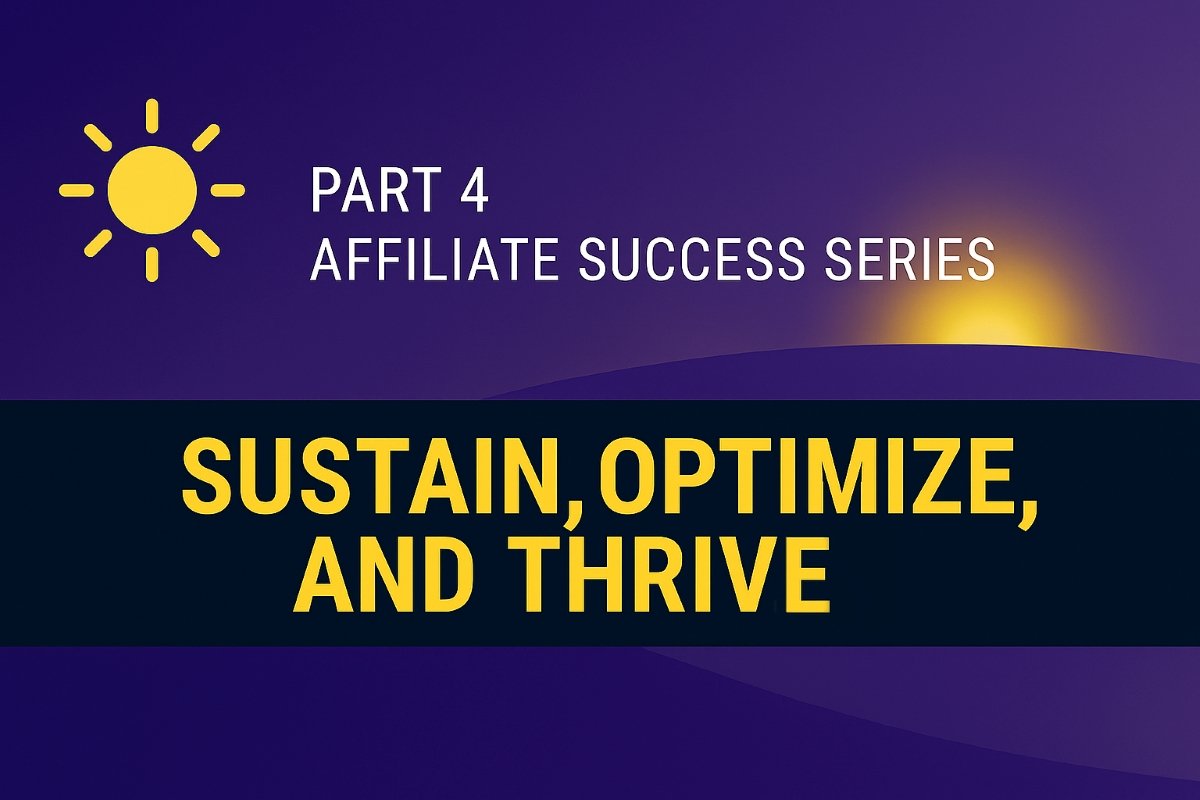Article Series Updated October 18, 2025
Affiliate Success Part 4: Promoting Products
Welcome back to Affiliate Success Part 4, the final section of this training series. While this is the last installment, it’s by no means the final step for your business. Affiliate marketing is an ongoing journey, and once you implement these strategies, you’ll want to keep learning, testing, and refining.
To recap:
Part 1 – Choosing your niche
Part 2 – Building your platform
Part 3 – Growing your audience
Now, in Part 4, we’ll tie it all together by focusing on how to promote products effectively to your audience.
If you’ve followed along and put the earlier steps into practice, you should already have a foundation in place: a niche, a platform, and the beginnings of an audience. That’s critical, because your success in promoting products depends on the groundwork you’ve laid.
Step 4: Promoting Products
Promoting products is where everything comes together. Done right, it not only generates sales but also strengthens your relationship with your audience.
Only Promote What You Believe In
The golden rule: only promote products you believe in.
Test the product first. Buy it yourself or request a review copy from the vendor.
Reach out professionally. When asking for a review copy, explain your platform, audience, and how you plan to promote. Reputable vendors who value affiliates will often provide one.
Evaluate the vendor. If they ignore your request, it may signal poor customer service or weak affiliate support—both red flags.
If you can’t get a review copy, consider purchasing the product. Being able to share your personal experience makes your promotions far more authentic and persuasive.
Writing Reviews
Reviews are one of the most effective ways to promote affiliate products. They work best when you:
Share your personal experience with the product.
Highlight the results you achieved or the problems it solved.
Cover both the pros and cons honestly.
Clarify who the product is for and who it’s not for.
This honesty makes your reviews believable and trustworthy. For example:
“This product is great, but it only comes in video format. If you prefer reading, it may not be the best fit.”
“Some sections felt a little long‑winded, but overall the content was excellent.”
Not every product is right for everyone. Be upfront about that. If you oversell and someone buys the wrong product, you’ll lose their trust.
You can also:
Tie reviews back to your own experience, even if you don’t personally need the product.
Publish reviews in multiple formats (text, video, audio, or email).
Combine reviews with bonuses for maximum impact.
Bonuses

Bonuses add extra value for your audience and help protect your commissions. They can tip the scales when someone is on the fence about buying.
Best practices for bonuses:
Add urgency (e.g., “Bonus available for 7 days only” or “First 100 buyers get this bonus”).
Make sure your bonus is relevant and genuinely useful.
Verify purchases by asking buyers to forward their receipt so you can confirm through your affiliate dashboard.
Bonus ideas:
Personalized step‑by‑step guides
Tip sheets or condensed summaries
Blueprints or process maps
Q&A documents addressing common questions
Interviews with the vendor
Add‑ons (extra recipes, templates, or tools)
Custom videos or PDFs
Vendor‑provided bonuses (easy, but less unique)
The goal is to make an already good product even better while showing your audience you care about their success.
Recommended Resources Page

A recommended resources page is a powerful way to centralize your affiliate offers.
Create a page with mini‑reviews and affiliate links.
Add it to your site’s navigation menu.
Position it as your “go‑to list” of trusted tools, books, or products.
This works especially well because your audience already trusts your judgment and wants to know what you personally recommend.
Promotions to Your List

Email remains one of the most reliable and profitable ways to promote affiliate products.
Why email works:
Deliverability is high compared to social media.
Subscribers already like your content and want to hear from you.
You own the list—it’s not subject to algorithm changes.
Tips for email promotions:
Write in a sales copy or pre‑sell style. Focus on benefits, not just features.
Personalize your recommendations—don’t just copy vendor text.
Share your own results or those of other buyers.
Use plain text emails—sometimes they outperform fancy templates.
Combine with other methods (e.g., reviews + bonuses).
Last Words…
In Affiliate Success Part 4, we revealed that running affiliate promotions isn’t just about pushing products. It’s about:
Respecting your audience.
Building trust through honesty and transparency.
Adding value with bonuses, resources, and thoughtful recommendations.
Always remember: your audience is made up of real people with real needs, goals, fears, and dreams. Treat them with respect in everything you do—your content, your communication, and your product choices.
Do that consistently, and you’ll build the kind of trust that makes affiliate marketing not just profitable, but sustainable.
Congratulations — you’ve completed all 4 parts of the Affiliate Success training series!


This is a really great series Michel, full of tons of valuable information. Affiliate marketing is definitely a great business model if set up correctly.
Thank you, Sue!
That was the purpose for this series, to help those who are interested on the right track. The information that I shared basically “gave away the farm.” However, most people still need a mentor or coach to keep going, which I’m working on next. 🙂
Also thank you for visiting and leaving a comment!
Wow, Michel, there is a ton of really useful info here.
Have you promoted products sold through JVZoo or Clickbank? I just discovered that the bonus can be delivered automatically by them – so it saves you having to check the receipts.
Looking forward to next week’s post 🙂
Jennifer
Hello Jennifer, thanks for visiting and leaving a comment!
I already knew that JVZoo allows affiliate marketers to add bonuses onto the vendor’s product if someone buys through that affiliate’s link. And yes, it’s a time saver along with faster delivery and less steps for the buyer. I wasn’t aware of Clickbank setup to do the same thing.
However even though convenient, using that system as an affiliate doesn’t allow you to capture the buyer’s email address for your own list. As we all know, you want proven buyers who have some experience with you so that you can send them future offers directly through email. If you use the bonus delivery system of either JVZoo or Clickbank, you lose that ability. 🙂
Wow, Michel.
This is way above and beyond. You could easily package this all up and sell it as a product. This is so thorough and well-considered. Amazing!
Cheers,
Rob
Thanks Rob for your comment.
I plan on putting this all together as either a front end product or use as a bonus for other offers. The main point is that I will leverage it for maximum potential and mutual benefit.
Great stuff, Michel. I definitely agree with your first point, “only promote what you believe in.” People learn to trust you when you promote quality products and sellers, but you also feel much better about yourself when you do things the right way.
Thanks Patti!
Also when you promote only what you believe in, it is easier to do and you do a better job with it yourself!
Hi Michel,
Wow! I wish I had read this excellent explanation when I first started with affiliate marketing. This is definitely a course I would have bought to better understand how to make my promotions more profitable.
Well thank you, Susan glad you enjoyed it! 🙂
Nice post Michel!
The information in this post is really nice and down to earth. It really talks to me about promotion of affiliate products.
I like to use a plugin alled Ninja affiliate to cloke my links and also keep track of what is being clicked on.
All The Best
Edward Haberthur
Thanks Ed for visiting, commenting and sharing your link cloaking tip. 🙂